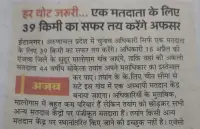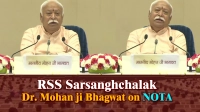Searching for victims of heroes in itihāsa is an old preoccupation of the enemies of the spirit of old lore (purāṇa vairi-s). That is a way of undermining the qualities that the civilization sees as heroic, and replace in collective psyche their images with icons of lower stature, representatives of qualities that prevent higher civilizational aspirations. While the enterprise is a big one, highlighting victims of heroes of epics helps (a) bring a doubt about their character and loftiness of the heroes (b) highlight defects in collective morality that sees the heroes as heroes.
When epics are not dominant in the collective consciousness, villains of epics can be directly highlighted as martyrs – Mahiśa, Rāvana etc. When epics come more into the fore, as happened recently during the lockdown thanks to the epics telecast on Doordarshan, villains of epics for their moral decrepitude cannot be highlighted by the purāṇa vairi-s because they then start looking like villains themselves.
Though for decades Rāvana was praised and Rāma was called an Aryan invader in some regions, now in most parts that line is not publicly acceptable – a rapist and an abductor of women cannot be called a martyr instead of a villain given the recent public anger for crime against women.
So the purāṇa vairi-s take to a different set of victims. Those that are not inherently negative characters but fell “victims” due to the poor moral compass of the heroes and society that produces those heroes. Sīta, Draupadi etc.
We learned recently that Subhadra was a victim of misogyny, forcefully taken away and married by Arjuna, and that her victimhood is not even mentioned in discourse. So it makes occasion to look at her case.
It is also a good occasion to look at kanyā haraṇa itself. Subhadra was not an isolated case of kanyā haraṇa, in fact kṣatriyas are “permitted” as an alternate method of getting wife, apart from the known brahma and gāndharva modes.
A simple survey of epics reveals easily, the fact that heroes of epics are men who always stood for protecting not just woman but woman’s right to make her choice. That becomes a topic in itself, so we can limit the current topic to kanyā haraṇa.
Dharma
Needless to say, it is not an appreciable practice to take a girl by force. Yet, it was a “permitted” thing for kṣatriyas. At this point it needs to be understood that smṛti/dharma ṣāstra is not prescriptive – it does not say “do this, do that”. It says “this is the nature of things, doing this has such result, and this is therefore the most doable or most avoidable thing”.
In that sense if seen, the dharma ṣāstras do not say “kṣatriyas should do this” but “it is a practice among kṣatriyas to do this”.
The different modes of marriage are mentioned in dharma ṣāstra texts. One instance is Manusmṛti (starting from verse 3.27). Brahma is the best mode of marriage. Arṣa, daiva prājāpatya are good modes where there is a family level agreement. Gāndharva is allowed for kṣatriyas where there is a mutual consent between the man and the woman, and no formal approval from parents is sought. Rakshasa is a discouraged mode where the girl is taken by force.
Why would such a marriage be allowed in a civilized society, and why it is sanctioned without prohibition? Why is no penalty imposed on the man? That too in a civilization that has practices like swayamvara, where woman’s choice is given primary importance? There are multiple reasons for this.
- Ultimately it is the woman that is the loser. Bride has no legitimate status if the marriage is not legitimized. The girl can leave the man when she is freed, in case of abduction and captivity. The fate of a girl isolated after abduction is kept in mind, and therefore it is nevertheless listed a marriage while heavily discouraged.
- It is also possible that the abduction happens with girl’s consent. Though this is still haraṇa, it is still a right thing.
The possibilities in life are many, and when it comes to the question of which of the choices is “right” and which is not, the pedagogy of dharma ṣāstras also gives us simple tests: any action that begets negative consequences is not in line with dharma. In cases where there are uphill tasks, facing lot of struggle and suffering but eventually results are positive, the choice is in line with dharma.
Yudhiśṭhira’s choices in dice game are shown to have negative results, and he is shown as expiating for his wrongs. So the lesson there is clear as to whether one should stake property and humans in a dice game, whether one should play without being adept, whether a game should be used to decide anyone’s fate at all.
Kanyā haraṇa episodes also have such lessons, in which case the choice has positive results and in which case it has negative results.
We know of at least three instances of kanyā haraṇa in itihāsa. First is Bhīśma taking the three princesses of Kāśī raja. Second is Kṛṣṇa taking Rukmiṇi. Third is Arjuna taking Subhadra.
These three happened in three different circumstances, and the merit and permissibility of kanyā haraṇa is different in all three.
Case 1 – Ambā (Adi Parva Section 102)
Bhīśma wanted brides for his brother Vicitravīrya. Given Vicitravīrya was not known to be a great prince, by character or power or charm, not many kings came forward to give their daughters.
Bhīśma comes to know of Kāśī raja who announces a swayamvara for this three daughters Ambā, Ambikā and Ambālikā. There is no invite to Hastināpura. Bhīśma took a vow to remain unmarried and childless for life, and he was among the most eligible bachelors in Bharata. Vicitravīrya does not have a good name and gets no invite.
This angers Bhīśma, and he barges into the swayamvara, challengs the court to stand him in a battle if someone wants to stop him from taking the three brides for his brother Vicitravīrya, the heir of Hastināpura throne. Given Bhīśma’s standing as a warrior none could face him. Sālva king challenges Bhīśma to get Ambā his lover, and fails. Bhīśma comes to Hastināpura with the three princesses. Ambikā and Ambālikā get married to Vicitravīrya, soon to be widowed. Ambā reveals her love for Sālva and Bhīśma sends her to Sālva. Sālva having lost her in a fair fight, declines to own up Ambā.
Ambā is left nowhere. She demands that since Bhīśma used his power to get her from her father as well as her lover, he must marry her. Bhīśma is bound by vow, and declines. Then Ambā requests Bhīśma’s teacher Paraśurāma to persuade Bhīśma, he too fails. Ambā does tapas for Rudra, leaves her body, a part of her becomes Ambā river and another part takes rebirth as Sikhandi who becomes the cause of Bhīśma’s death.
This is a kanyā haraṇa, and the wrongs committed here are many:
- Woman belongs to the man who won her. This is itself breached when Bhīśma used his power to win brides for his ineligible and incapable brother. A woman can live with a man who sought and won her, but not with a man who needs proxies to get her. It was not a case where Vicitravīrya sought the girls and stood, while Bhīśma’s power came to rescue.
- Bhīśma ignores the fact that Kāśī raja announced a swayamvara and not a contest. Unlike Draupadi or Sīta “swayamvara” which was more a contest and the girl goes to one who clears a test, Kāśī raja announced a self-choice where the girl picks the man she wants to marry. Bhīśma’s show of power to overrule a self-choice is the second wrong.
- When Sālva challenged Bhīśma, it does not occur to him whether Ambā could also have been interested. Ambā gets her chance to talk only after reaching Hastināpura.
Eventually since Bhīśma could not break his vow, Ambā’s life is ruined and she became the cause for Bhīśma’s death.
The lessons here are clear: one cannot forcefully take a woman when her interest is elsewhere. Show of power style representation is not acceptable for marriages. Given the negative consequences Bhīśma and Hastināpura has, this case of kanyā haraṇa, its method, motive all stand wrong.
Case 2 – Rukmiṇi
Kṛṣṇa’s story is too famous, but a quick recollection helps conclusions. Vidarbha princess Rukmiṇi has Kṛṣṇa in her heart. Her brother Rukmi a friend of Kṛṣṇa’s enemies, is keen on getting her married to the man he likes and not the man his sister likes.
Rukmiṇi, intent on marrying Kṛṣṇa, sends a messenger. Agni Dyotana, a respected and learned man, goes to Kṛṣṇa and conveys the longing Rukmiṇi has for Kṛṣṇa, the constraints she has and asks him to take Rukmiṇi from Vidarbha. Kṛṣṇa waits at the outskirts of capital where Rukmiṇi comes to pray to her deity, comes on a chariot and takes her. The chariot is pursued by Rukmi, Kṛṣṇa stops and instead of killing his to be brother-in-law he shaves Rukmi and dispatches him back to Vidarbha.
This is a classic story of heroism, romance, love. It is not only read with great interest as a story, there is a practice in several regions to chant the episode by girls with the belief they will get married to a suitable and good man.
The antecedent and consequent are also clear: when the girl is interested, go to any length to get her. Yes, this too is a kanyā haraṇa – a stealing of Vidarbha princess from Vidarbha perspective. Yet this is always mentioned only in a positive sense.
Case 3 – Subhadra (Adi Parva sections 221, 222)
Arjuna goes on an expiation exile and as part of it reaches Dwaraka. He sees Subhadra Kṛṣṇa’s sister, and has an instant attraction for her. Kṛṣṇa suggests that Arjuna abducts Subhadra and marries her.
Arjuna picks her, just like Kṛṣṇa picked Rukmiṇi, from outside the temple on a hilltop outside the capital. He reaches Indraprastha and their marriage happens. Yādavas in Dwaraka are enraged and Kṛṣṇa pacifies them saying Arjuna is the best possible groom they can ever hope to get for Subhadra, and they give their acceptance to the marriage.
The difference however, is this was not a case of girl taking the initiative. This was also not a case of Arjuna getting Subhadra’s acceptance before he takes her. This is also not an episode that is as celebrated as Rukmiṇi haraṇa.
Yet, we see no negative effects of this in the epic. It can be argued that since Subhadra knew Kṛṣṇa’s relation with Arjuna she had no hope of getting support and reconciled with life once she knew it was Arjuna who abducted her. This is not a valid argument, because the Yādavas including Balarāma were still around if she really wanted to protest. Yudhiśṭhira the Dharma raja himself would not approve of a match had Subhadra protested her abduction once they reached Indraprastha. To the contrary, it can be argued that Balarāma was in favour of Subhadra’s alliance with Hastināpura and Kṛṣṇa favored Arjuna as a friend and also as a better human and warrior. He sought a better man for his sister and suggested abduction because Subhadra did not make any decision. Possible arguments are many.
One question that arises in the latter argument is what happens to the consent of the girl. What is ignored while asking this question is when the consent did not matter (because the girl did not exercise it, not because the consent was overruled), what matters is getting the right man. Arjuna’s character throughout the epic is blemish less. He declines Ūrvaśī’s advances because he does not see in her a lover but an ancestor. He was the one to get whom as a son-in-law, kings conducted sacrifices and begot daughters. He declines marrying Uttara because he saw in her a student. A man of impeccable character, a man who knew exactly when to advance and when to stop, cannot be blamed for applying force on a woman without realizing where he could cross the line.
There are multiple versions in this story, and according to some accounts Kṛṣṇa advises Arjuna to abduct Subhadra. Some hold that Subhadra also had a liking for Arjuna and she went with him willingly, and was even driving the chariot. The implication in former version is that Arjuna abducted a lady who has not made up her mind (and was not against the alliance either) with the consent of her brother. The implication of the latter version is that this is another romantic story which is made out to be an issue for no reason.
But what is known is that Arjuna arranged for Subhadra’s meeting with Draupadi in a way their relation turns good. What is also known is that Subhadra is not known to have protested. What is also known is that Arjuna got a beautiful as well as affectionate wife in the form of Subhadra, and an illustrious son like Abhimanyu. There is no negative consequence coming out of this “stealing the girl” that came to Arjuna or Pānḍavās due to this that the epic narrates.
Because, unlike Bhīśma’s case, Arjuna wanted to win over his lady. Unlike Ambā’s case, this was also a great match – Arjuna was the best possible groom for a princess in that age, and had love for Subhadra. The bond between Kṛṣṇa and Arjuna, Arjuna’s character, every factor was in favour of a happy marriage for Subhadra with Arjuna. Unlike Ambā’s case, Subhadra was also not having another man in her mind and was positively inclined to Pānḍavās due to Kṛṣṇa’s relation. From Subhadra’s viewpoint the only misgiving is not taking her acceptance, which, while being a major matter today, was hardly a big issue back then. When matches were arranged by elders barring exceptions, the boy and girl both go with the match arranged by parents. Given this, and given that Kṛṣṇa’s blessing was there, Subhadra had not a major reason to be unpleasant or express it.
Conclusion
While there are many other situations, these three reveal a fair diversity of kanyā haraṇa phenomenon along with their correctness, acceptability and consequences in the epic.
To conclude, kanyā haraṇa was not entirely proscribed because there were cases it had merit. At the same time, it was kept as one of the last chosen methods, to be resorted to after exhausting better ways and options.





Leave a comment